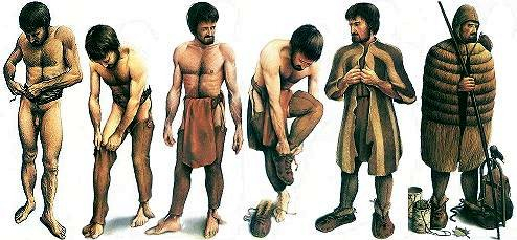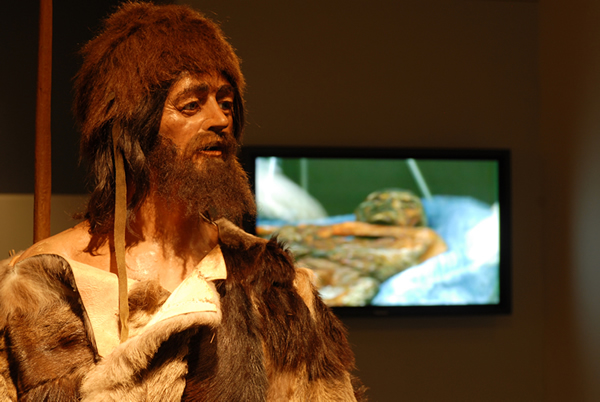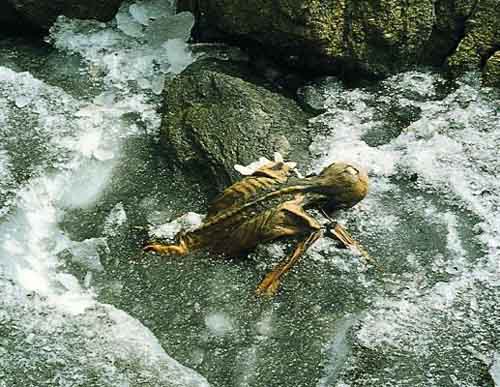On Thursday, September 19, 1991, at about 1.30 p.m. on a sunny afternoon Erika and Helmut Simon, from Nuremberg in Germany, were enjoying a vacation half-walking and half-climbing through difficult icy and rock-strewn terrain high up on a mountain overlooking the Otzi valley in the Alpine borderlands between Austria and Italy.
On their descent from a peak near Tisenjoch they strayed a little from the recommended route in the hope of finding a short cut and, as they traversed a rock-strewn elevated plateau near a retreating mountain glacier at some 3210 meters above sea level, they passed a gully filled with thawing ice and melt-water within which they noticed something unusual. Further investigation showed this object to be an actual human corpse.
Much of these human remains lay under the ice and melt-water but the back of the head and upper back and shoulders were exposed - the Simons also noticed several pieces of rolled-up tree bark near the body and took a picture of what they now presumed to be the unfortunate victim of some sort of, quite recent, accident on the mountain before leaving to report their find.
No more pictures were taken that day because their camera used rolls of photographic film and when they discovered the body their camera's roll of film was nearly used up.
The following day two "officiating" Austrians, a policeman and a mountain rescue officer, showed up to try to recover the remains - with the aid of a pneumatic drill! Unfortunately the weather was markedly less kind than when the body was discovered and the pair worked semi-immersed in freezing waters and some damage was done to the left of the frozen ice mummy as it lay under the ice and the freezing cold water.
The pair found that they could not achieve recovery with the equipment the had brought with them that day. Further efforts at recovery took place over the next few days amidst difficulties over the availability of helicopters, heavy snowfalls, and steep drop-offs in temperature. On sunday 21st many objects strewn at a various distances around the gully were recovered. The next day the ice mummy itself was removed under the supervision of a forensic expert with the process being recorded on film. Numerous pieces of leather and hide, string, straps and clumps of hay were also recovered and preserved for further study.
The remains were then taken to the Institute of Forensic Medicine in Innsbruck, Austria.
Fatalities occur every year in the high alps due to such things as climbing accidents, exhaustion, adverse weather or sudden deaths. The bodies of such victims are often recovered shortly afterwards but they can also subsequently disappear into the snowy landscape. Although some six bodies had already been recovered from the high alps already in 1991 an archaeological expert was called in to give advice in this particular case because some of the artifacts discovered seemed to be potentially very ancient.
This archaeological expertise arrived on the scene all of five days after the initial discovery and the Ötzi ice mummy was recognised as being of great antiquity. Steps were taken to better preserve the remains by controlling temperature and humidity conditions.
International complications came into play as, although the body was discovered in a place where waters as they drained from this part of the Alps flowed towards Austria, its actual resting-place was confirmed, by a subsequent border survey of early October, to have been some 93 metres inside the Italian border. Agreements were reached between the relevant authorities allowing for the continued responsibility for the investigation of the corpse to lie with the Forensic Institute at Innsbruck.
A dispute about "ownership" of Ötzi the Iceman, as the remains became known in an emerging world-wide fascination with this "cold case" of an ice mummy found on the Austrian-Italian frontier, continued for six years until, early in 1998, under armed guard, (because some Austrians had shown dis-satisfaction to see this relocation), Otzi and his belongings were transported from the Institute of Anatomy of the University of Innsbruck over the Brenner Pass to a new and purpose-built refrigerated resting place in a converted former bank building selected for its favourable location in the historical center of Bolzano - of an important town within Italy that was reasonably close to the actual discovery site: the conversion cost some €8,800,000 then roughly equivalent to $10,000,000.
This converted building is now known as the South Tyrol Museum of Archaeology and is located in the provincial city of Bolzano in Italy's largely German-speaking Alto Adige / Sud Tyrol / South Tyrol region.
The gully in which the body was found had helped to preserve it, in its frozen state, from the immense weight of snow which seems to have covered the site for most of the several millenia since Ötzi, ( pronounced Oot-zee, and often actually spelled Oetzi ), lost his life. Ötzi's remains must have been claimed by icy cold quite soon after his demise as even his internal organs were found to be intact - they were able for instance to actually analyse his stomach contents which included ibex meat and primitively cultivated "einkorn" grains.
Over several years of subsequent investigation forensic findings relating to this frozen body in the Alps included the time of death as being some 5,300 years ago - in the late stone / early copper age! The deceased being a male of some 45 years of age with tattoos on his body and worn, but otherwise perfect, teeth and a probably quite troublesome infestation of intestinal whipworms. The deceased had come to a violent end - an arrowhead was found buried in the body and there was evidence of Ötzi having been heavily struck on the head perhaps with a blunt instrument or perhaps as the result of a fall.
The medical examination held that either the arrow wound or the head trauma were sufficiently damaging as to cost Otzi his life.
Based on the evidence of the several artifacts found together with the remains researchers now attribute a perhaps surprising degree of technological attainment to the Ötzi the Iceman and his late stone / early copper age colleagues. It was realised that those trying to recover the body had unwittingly trampled all over a hugely significant archaeological site and had even broken Ötzi's stone-age bow and the frame of his stone-age back pack, in trying to prize him from the ice.
There is evidence of quite detailed attention to the preparation of clothing with which to dress against the cold:-
The above selection of items, (a bow made of yew and a quiver full of arrows were also recovered), include an axe with a handle of yew together with a refined copper blade held in place by leather strips and a type of tarry pitch derived from processed birch tree sap. In fact it was largely the finding of this 99.7% pure copper blade in circumstances which allowed dating to five thousand three hundred years ago that pushed back archaeologists previous assessment of the beginnings of the so-called "copper age" in Europe by a thousand years!
Traces of copper and arsenic were found in Ötzi's hair consistent with some exposure to fumes from copper smelting.
There is also a flint blade knife with its scabbard (on right), and the tubular item in the centre is called a retoucheur.
This example of a retoucheur is an approximately 12 cm-long pencil-like tool for working with flint was made from a piece of lime branch which was shaped to a point at one end. At the pointed end an approximately 6 cm-long rod was driven into the central canal, leaving a few millimetres protruding. The rod turned out to be the fire-hardened point of a stag’s antler.
To fashion tools of flint, a flint cobble would first be hammered with hard blows to produce flakes and crude blades. These were then precisely shaped by pressing against the edge of the workpiece with a retoucheur to remove small fragments. The same method is used to resharpen dull edges.
When the end of the retoucheur became blunt with wear, it could be sharpened like a pencil.
As to the tattoos - one of several groups of vertical lines are located to the left and right of the spinal column. Others are on the left calf, on the right instep and on the inner and outer ankle joint, two further lines cross the left wrist. A cross-shaped mark appears on the back of the right knee and beside the left Achilles tendon.
Later researchers considered that the tattoos may have been intended as therapeutic measures to hopefully combat arthritis rather than as decorative or religious symbols as, astonishingly, these tattooed areas seem to correspond to accepted skin acupuncture lines. Before Ötzi it was thought that this treatment had only originated two thousand years later in Asia.
viewing window The remains of Ötzi the Iceman now lie in the Südtiroler Archeologiemuseum in Bozen / Bolzano in Italy's South Tyrol where they are stored in a nitrogen rich atmosphere under conditions of controlled temperature and humidity, which are designed to guarantee a constant temperature of -6 ° C and a relative humidity of 98%, for their preservation but can be seen through a 40cm x 30cm viewing window by interested visitors.
The space devoted to the Iceman occupies most of the first floor of the museum and consists of a decontamination room, an examining room, and two adjoining identical refrigeration chambers with independent cooling systems.
There has, seemingly, been some discussion as to whether Otzi should be allowed to have a "decent" burial ceremony and be "laid to rest" away from the public gaze.
The museum authorities consider, however, that they do try to treat his remains with respect and with scientific care - they also point out that after 5,300 years old they would not be able to bury him in accordance with the ceremonial customs of his own people.
Besides which science can hope to learn much from Otzi in his present situation. Recent advances in the study of DNA, for example, have led to the decoding of Otzi's entire DNA genome, in 2010, from which Science can hope to learn important lessons about the development of modern man's genetically related susceptibility to certain diseases.
Source from : http://www.age-of-the-sage.org
For more interesting topics related to archaeology, visit archaeology excavations.
Archaeology excavation is best known and most commonly used within the science of archaeology. In this sense it is the exposure, processing and recording of archaeological remains.
Thursday, February 10, 2011
Otzi / Oetzi - The Iceman of the Alps pictures images
Subscribe to:
Post Comments (Atom)





4 comments:
Nice summary. Thanks.
I was looking for more information re: the artifacts that were with Otzi when he died.
Two things have always mystified me about this case:
1) Otzi is presumed to have died in the Spring/Summer. If then, in the middle of an Alpine Summer, then why wasn't there more decay? It would seem to me that despite the pollen ingestion, that common sense would lead us to believe that Otzi would have died in the later Autumn/early Winter when the snows would have covered him and preserved him.
2) Many have assumed that Otzi was murdered on the site or near where he was found. If so, why weren't his artifacts taken? Is it not more plausible that he may have been attacked at a lower altitude, then in his weakened state retreated to the higher ground, an area which he may have been more familiar with and, where he may have stored other artifacts (the ones he was discovered near). It seems more logical that he was attacked and sustained life-threatening wounds elsewhere, then returned to a location where he felt safer and one in which he already had the axe, bow & quiver, etc. hidden away from others. The attackers would have just seen him as running away from where the attack occurred, seemingly without any arms of any kind. Otzi retreats knowing that he needs to get back to his reserve of arms in case he is followed. He needs to produce more arrows however. His attackers never follow him, thinking he is mortally wounded and they don't need any more from him than they have already taken. Otzi's wounds are so pronounced that he dies before he can complete any further work, or he faints and falls off a rock, hits his head in the process and dies in the trench where he is covered with snow.
My thoughts.
I would love to know what else was recovered in subsequent "digs" on the site of his glacial interment.
Mark M.
You should get the book The Iceman and his Natural Environment. It goes into great detail of different items found during the excavation process as well as his diet.
Do you need Personal Loan?
Business Cash Loan?
Unsecured Loan
Fast and Simple Loan?
Quick Application Process?
Approvals within 8-10 Hours?
Funding in less than 1 day?
Get unsecured working capital?
Contact Us At: standardonlineinvestment@gmail.com
LOAN SERVICES AVAILABLE INCLUDE:
================================
*Commercial Loans.
*Personal Loans.
*Business Loans.
*Investments Loans.
*Development Loans.
*Acquisition Loans .
*Construction loans.
*Credit Card Clearance Loan
*Debt Consolidation Loan
*Business Loans And many More:
LOAN APPLICATION FORM:
=================
Full Name:................
Loan Amount Needed:.
Purpose of loan:.......
Loan Duration:..
Gender:.............
Marital status:....
Location:..........
Home Address:..
City:............
Country:......
Phone:..........
Mobile / Cell:....
Occupation:......
Monthly Income:....Contact Us At: standardonlineinvestment@gmail.com
Thanks and look forward to your prompt reply.
Regards,
Muqse
My name is Samuel, I was in love with my wife and we were married for eight years with a son his is Liam,I loved my wife so much she had access to all my bank account and even my cash app which my accountant agreed to and said it was a great idea, then it took my wife and my accountant two month to get hold of all my properties,all accounts but I had a cash app which they knew nothing about,I was thrown out of my own house was sleeping in a hotel for weeks she also took possession of my son could only see him once a week then I found out she was in love with my accountant all these while so I went online and I came across a Russian private investigator who help me get all my properties and my accounts back even my company back how he did these I don’t know but I gave all the information he asked for and followed all his instructions and now I’m happy my life’s better now.
Thanks to premiumhackservices@gmail.com
I just said I should share my own story here
Thank you
Post a Comment